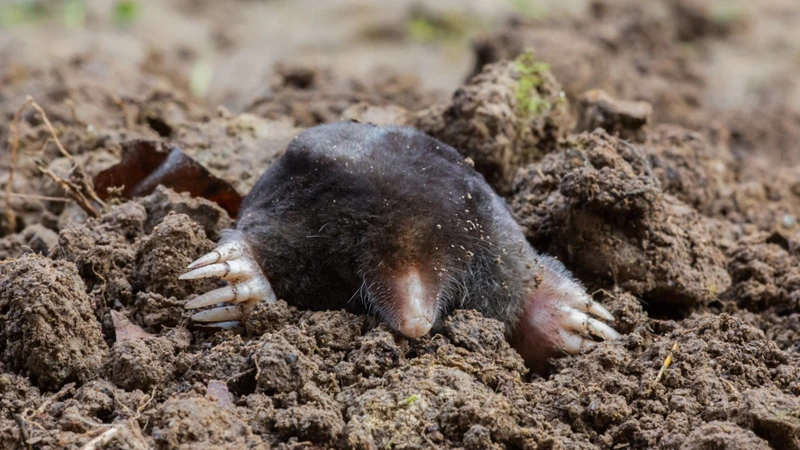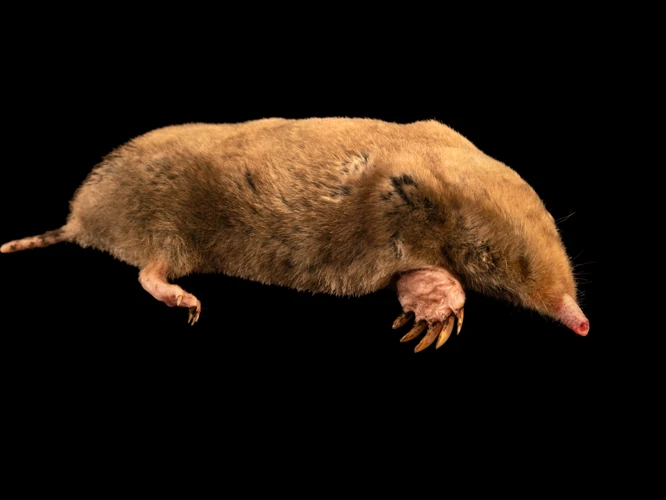The elusive nature of moles has long been a subject of perplexity for researchers and nature enthusiasts alike. These small, burrowing creatures are well-known for their distinctive physical characteristics and even more distinctive digging habits. Despite being regarded as pests by many, moles are fascinating creatures with intricate social lives. One question that often arises is whether these creatures live alone or in groups. In this article, we will explore the social habits of moles and delve into the factors that influence their behavior. Join us as we uncover the mysteries of these fascinating creatures.
Basic Mole Habits and Characteristics

The underground world of moles is fascinating, and understanding their basic habits and characteristics can shed light on their remarkable adaptations. Moles have unique physical features that enable them to thrive in their subterranean environment, as well as distinctive behaviors that make them successful hunters and diggers. In this section of the article, we will delve into the appearance and diet, behavior and lifestyle of moles without forgetting crucial details of their daily routines and sleep times. We will explore their burrowing habits, touching on their digging, depth and marking techniques. No wonder that knowing such habits may be vital, especially when it comes to comprehending the intricacies of the social constructs of these creatures, we will look at in the following parts.
Appearance and Diet
Moles are small mammals that belong to the Talpidae family. They have adapted to a life underground, and their physical characteristics reflect this. Moles have small, round bodies with short legs that are broad and muscular, and their fur is usually dark or black, making them well-suited for life in the dark tunnels they dig.
Beyond their unique appearance, moles also have interesting eating habits. Their primary diet consists of insects, earthworms, and other small invertebrates that they find in the soil. Moles have a high metabolism and need to consume a lot of food relative to their size. As a result, they are constantly foraging and eating. In fact, they can consume up to 80% of their body weight in a single day!
To help them in their quest for food, moles have evolved specialized physical characteristics. Their large, spade-like front paws are perfectly adapted for digging and burrowing. Moles also have small eyes and ears, as they don’t rely on sight or hearing to navigate underground. Instead, they use their sense of touch and smell to find their prey.
Moles’ unique appearance and diet make them interesting creatures to study. To learn more about their eating habits and the way they forage, check out our article on mole’s eating habits.
Behavior and Lifestyle
Moles are primarily solitary creatures, only coming together during the mating season. These tiny creatures are nocturnal, meaning they are most active during the night. They live underground and are well-adapted to digging and burrowing in search of food, which they must do often due to their high metabolic rate.
One of the most important aspects of a mole’s behavior and lifestyle is their burrowing habits. Moles are known for creating extensive tunneling systems that can reach depths of up to 2 feet into the ground. These tunnels serve many purposes, such as providing access to food sources, protection from predators, and shelter from extreme temperatures. The tunnel system also helps to aerate the soil and distribute nutrients.
In addition to their burrowing, moles have other distinctive behavior patterns. They spend most of their time foraging for food, which generally consists of insects, worms and other small creatures found underground. Because of their tiny eyes, they rely heavily on their sense of smell and touch to navigate.
Moles are also known for their low energy expenditure. They have very slow metabolisms, which means that they don’t need to eat as frequently as other animals their size. In order to conserve energy, moles have developed unique sleep habits. They sleep for short periods throughout the day, usually waking up every few hours to eat and check their tunnel systems.
Despite their generally solitary lifestyle, there are some situations where moles may interact with other members of their species. During the mating season, males will seek out females in order to mate. This is one of the few cases where moles will actively seek out one another.
Moles have an interesting and complex set of behaviors and habits. From their burrowing patterns to their specialized sleep routines, they are well-adapted to living in the underground worlds they create. To learn more about mole burrowing behaviors, see our article on moles’ burrowing habits and depths. Alternatively, if you’re interested in mole mating habits, check out our article on mole mating habits.
Moles and Territory

As we know from our previous discussions on moles’ daily routines and sleep habits, these tiny creatures are territorial by nature. They take the idea of “mi casa es su casa” very seriously, and their underground kingdom is governed by a clear and defined set of territorial rules. And, as you might expect, territories play a crucial role in the social behavior of moles. In this section, we will explore the different ways moles establish and defend their territories and how this affects their social habits.
Digging and Tunneling
Moles are known for their impressive digging and tunneling abilities. Digging tunnels helps moles create a safe and hidden space to live and hunt for food, while also helping them move around their territory quickly and easily. Here are some key points to understand about moles’ digging and tunneling habits:
- Powerful front claws: Moles have large, powerful front claws that are specially adapted for digging through soil and dirt. These claws are curved and sharp, allowing them to easily break through the ground and create tunnels.
- Shallow and deep tunnels: Moles create both shallow and deep tunnels. Shallow tunnels are around 6-12 inches below the surface and are used for foraging, while deeper tunnels can be over 2 feet deep and are used for nesting and resting.
- Creating feeding tunnels: Moles create feeding tunnels where they search for insects to eat. These tunnels can be recognized by the raised ridges that appear on the surface of the ground.
- Hills and molehills: Moles push the soil up to the surface as they dig tunnels, which creates mounds of dirt on the ground called molehills. These molehills can vary in size and shape and can be useful for identifying where moles are active.
Digging and tunneling are essential behaviors for moles, helping them find food, create shelter, and navigate their territory. To learn about moles’ hunting habits, check out our article on moles’ hunting habits.
Marking their Territory
Moles are territorial animals who mark their territories using various methods. It is essential for them to establish and maintain their territories to avoid conflicts with other moles. Here are some of the ways moles mark their territories:
- Urine marking: Moles use their urine to mark their territories. They leave small amounts of urine at the entrance to their burrows or on the soil around them. Other moles can detect the scent and avoid venturing into another mole’s territory. This method is most commonly used by males during breeding season.
- Scrapes: Moles also use scrapes to mark their territories. They use their front paws to scratch the ground, leaving behind a small pile of soil. These scrapes are usually located at the entrance of their burrows or on the surface of their territory. They serve as a visual marker for other moles to see.
- Sound: Moles also use vocalizations to communicate and mark their territories. They emit high-pitched sounds that are not audible to humans, but can be easily detected by other moles. These sounds can indicate aggression or mating intent, depending on the context.
These marking methods are crucial for maintaining territorial boundaries and preventing conflicts between moles. They help to establish social hierarchy within mole populations. Males, in particular, use these marking methods to compete for females during breeding season. Marking territories is an essential aspect of mole social behavior.
Territorial Conflicts
Moles are very territorial creatures, protecting their turf from any intruders that dare to cross the line. When two moles meet, it often results in a territorial conflict with both moles trying to assert dominance over the other.
The following are some common types of territorial conflicts among moles:
- Pushing matches: This is the most common type of conflict, where the two moles literally push each other back and forth, trying to force their opponent out of their territory.
- Physical fights: If a pushing match doesn’t work, moles may resort to biting, scratching, and even wrestling to protect their territory.
- Scent marking: Moles communicate through scent. In some cases, moles may use their scent to mark a territory, warning other moles to stay away.
- Sound communication: Moles make a variety of sounds, from soft chirps to loud growls. They use these sounds to communicate with other moles, often to warn them to stay out of their territory.
Territorial conflicts can be deadly for moles if they don’t back down. In some cases, a mole may be chased out of its territory and forced to find a new home. If the mole cannot find a new home, it may die from starvation or exposure. Territorial conflicts can also be dangerous for humans who attempt to remove or disturb moles, as the moles may become more aggressive and territorial in response.
Do Moles Live Alone or in Groups?

The social habits of moles have long been a topic of debate among researchers and animal enthusiasts alike. While some believe that moles may live solitary lives, others assert that they may be more social creatures, living in tight-knit groups or even colonies. In this section, we’ll delve deeper into the question of whether moles live alone or in groups, exploring the different types of social structures that moles may form and the various factors that may influence their social habits. Let’s explore the fascinating world of mole social behavior.
Loner Moles
When it comes to social habits, some species of moles prefer to live alone. These loner moles lead solitary lives and spend most of their time underground in their intricate tunnel systems. Here are some interesting facts about loner moles:
- They do not have a permanent home and may dig new tunnels each day- which can make their movements rather unpredictable.
- Due to their solitary lifestyle, loner moles do not leave behind any scent markings, which makes it difficult for other animals to track or locate them.
- Loner moles are not territorial, and they do not engage in fights or conflicts with other moles.
- These moles are primarily carnivorous, and they hunt for insects and small animals such as earthworms or small rodents.
- Since they do not have to share their food, loner moles can hunt more freely and have better chances of survival.
While it may seem lonely to some, the solitary lifestyle of loner moles allows them to avoid conflicts and potential competition for resources. Instead, they can focus on their individual survival and thrive in their own way.
Moles in Family Units
Family units are uncommon among moles, but they can exist in some species. Typically, a family unit consists of a breeding pair of moles along with their offspring. The size of the family unit may vary depending on the species and the availability of resources. In general, these family units tend to be smaller than colonies and are more closely-knit.
Species | Family Unit Characteristics
——– | ——–
Eastern Mole | Eastern moles are known to form family units consisting of a breeding pair and their offspring. The young may leave the unit once they mature, or they may remain with their parents to help care for younger siblings.
Hairy-tailed Mole | Hairy-tailed moles also form family units, but typically only for a short time during the breeding season. The male will stay with the female and help care for the young, but once the young are independent, the family unit dissolves.
Star-nosed Mole | Family units have not been observed in the star-nosed mole, but it is possible that breeding pairs may remain together while caring for their young.
In family units, all members typically work together to search for food and defend their territory. Since the young remain with their parents for some time, they can learn important skills and behaviors from their parents that will help them survive on their own once they leave the unit. Family units provide moles with a small, tight-knit social structure that may offer some advantages in certain circumstances.
Moles in Colonies
One interesting aspect in the social habits of moles is their ability to form colonies. Moles in colonies typically live together in large groups, collaborating to maintain their underground tunnels and searching for food. The colonies usually consist of young moles that are closely related to each other.
Benefits of Living in Colonies:
- Moles in colonies have a higher chance of survival than those living alone. They work together to defend against predators, are better at finding food, and can take care of each other’s young.
- Joining a colony can benefit young moles. They can learn important survival skills from their parents, siblings, and other adults in the colony.
Communication in a Mole Colony:
- Moles use various sounds and movements to communication within the colony. They frequently make high-pitched squeaks, low growling noises, and other sounds that are too high or too low for humans to hear.
- Moles also have scent glands, which they use to mark their territories and communicate with other moles. By smelling the scent markers, moles can determine the location of other moles within the colony.
Division of Labor in a Mole Colony:
- Like other social animals, moles in colonies divide labor among themselves. Some moles are good at digging and expanding tunnels, while others are better at finding food.
- Male moles in colonies generally leave to find mates, while female moles will stay and raise their young.
It’s important to note that not all mole species form colonies. The decision to live alone or in groups depends on various factors, such as environmental conditions and available resources.
Moles in Mating Pairs
When it comes to mating habits, moles are monogamous and form mating pairs. This means that once they find a partner, they will stay with them for the rest of their lives. The bond between the two moles is based on trust, communication and physical attraction.
Benefits of Mating Pairs:
– Maximization of Reproductive Fitness: This is because a pair will work together to defend their territory from other moles. They will also have more resources to access and check for predators as a team. As a result, they are more likely to have healthy offspring that can survive in their environment.
– Cognitive Development: Moles will also engage in social learning, where they learn from their partner how to better navigate their environment and find food.
– Emotional Support: Moles in mating pairs also provide emotional support to each other, as the bond between the two individuals helps in reducing stress, achieving better mental health and overall quality of life.
Once a pair of moles have found each other, they will mate once each year, producing up to an average of four offspring that will be born into the same burrow. The father helps raise the young by bringing them food, while the mother protects and feeds the young until they can fend for themselves.
However, even with mating pairs, moles are not very social animals, and once the young are old enough to leave the family burrow, the only time the moles will interact will be during mating season.
While moles are not known for being social creatures, they do form strong mating pairs to increase their chances of survival and maximize their reproductive fitness.
Factors Influencing Mole Social Habits
When it comes to understanding mole social habits, there are a variety of factors that come into play. These factors can include the environment surrounding the moles, as well as the species and genetics of the particular mole in question. Additionally, seasonal changes and climate can also play a role in how moles interact with each other and whether they live alone or in groups. By exploring these different factors and their potential impact on mole social habits, we can gain a better understanding of how these creatures live and interact with each other on a daily basis. Let’s dive deeper into these various factors and how they might be influencing mole social habits.
Environment and Resources
The social behavior of moles can be largely influenced by their environment and the availability of resources. Here are some factors that can affect mole sociability:
- Food availability: Moles are solitary creatures, but when food is scarce, they may tolerate the presence of others to increase their chances of finding food. On the other hand, when food is abundant, they are more likely to maintain their solitary habits.
- Territory size: The size of a mole’s territory can also impact their social behavior. If their territory is small and resources are scarce, they may not tolerate the presence of other moles. However, if their territory is larger and resources are abundant, they may allow other moles to come and go without conflict.
- Competition: Competition for resources can also affect mole sociability. When resources are scarce, moles may be more aggressive towards one another, whereas when resources are plentiful, they may be less likely to engage in territorial disputes.
- Population density: Populations of moles can vary greatly. When the population density is high, moles may be forced to interact more often and their social behavior may change as a result. However, when population densities are low, moles are more likely to maintain their solitary habits.
The environment and resources available to moles can play a significant role in their social behavior. While they are typically solitary creatures, moles may tolerate the presence of others when resources are scarce or when their territory is large enough to accommodate multiple individuals. However, competition for resources and high population densities can lead to more aggressive behavior and territorial conflicts.
Mole Species and Genetics
The social habits of moles are not only influenced by their environment and resources, but also by their species and genetics. There are several species of moles that inhabit various regions of the world, and each species have their different genetic makeup that affects their behavior.
Differences in Species
Some species of moles, such as Townsend mole and star-nosed mole, are known to live in colonies. These colonies are made up of closely related individuals who work together to establish and maintain their territories. Other species like European mole and American mole are a bit more solitary and are known to live alone or in family units.
Genetics Influence on Mole Social Habits
The difference in social habits of moles can also be determined by their genes. For example, certain genes can influence a mole’s ability to detect pheromones, which is crucial for their communication in groups. Moles with mutations that impact their sense of smell may have a harder time forming or participating in social groups.
Additionally, some moles may have genetic variations that make them more aggressive, leading to territorial conflicts with other moles. The ability to successfully compete for resources and defend territories is often key to a mole’s survival, and genetics can play a role in this behavior.
Interbreeding and Hybridization
It’s also worth noting that some species of moles can interbreed, which can result in hybrid offspring. These hybrids may exhibit different social tendencies than their parent species, as well as differing physical characteristics that can impact their behavior and preferred habitats.
The social habits of moles are complex and influenced by a variety of factors including their genetics and species. While some moles are naturally more social and thrive in colonies, others are more solitary and prefer to live on their own or in family units. These differences can be attributed in part to genetic variations that affect behaviors and communication.
Climate and Seasonal Changes
Climate and seasonal changes can also have a significant impact on mole social habits. Here are some ways in which this can occur:
- Winter Hibernation: In some areas, cold winters can lead to moles hibernating in their tunnels for long periods. This can make it more difficult for them to interact with other moles, decreasing the chances of socialization.
- Mating Seasons: The timing of mole breeding seasons can vary depending on the species and location. During these periods, moles may be more social as they search for mates and compete for breeding opportunities.
- Weather Patterns: Extreme weather events, such as droughts, floods, or heavy rainfall, can also impact mole social habits. For example, flooding can force moles to move to new areas and interact with unfamiliar individuals.
- Food Availability: Changes in climate can affect the availability of moles’ prey, such as earthworms or grubs. This can impact mole behavior, potentially increasing competition between individuals for scarce resources.
It’s clear that mole social habits are influenced by a range of factors, including environment, genetics, and seasonal variations. Understanding these variables can help shed light on the complex social behaviors of these elusive underground creatures.
Conclusion
In conclusion, the social habits of moles may vary depending on various factors such as their environment, resources, species, genetics, and climate. While some moles live alone as loners, others may form family units, colonies or pair up for mating purposes.
It is important to note that moles are fascinating creatures capable of complex behaviors and communication methods, including marking their territory and engaging in territorial conflicts. Their digging and tunneling abilities also play a significant role in their social habits as territories and resources become essential for their survival.
The study of moles and their social habits is crucial for better understanding their behavior and facilitating their conservation efforts, especially as human activities continue to impact their natural habitats.
With further research, we can gain more insight into the factors that influence mole social habits and how we can better protect and sustain their populations. Overall, the unique characteristics and behaviors of moles make them an essential part of the natural ecosystem, and their social habits are a fascinating topic for study and appreciation.
Frequently Asked Questions
What do moles eat?
Most moles primarily feed on insects and other small invertebrates found underground, such as earthworms and grubs.
How do moles mark their territory?
Moles will use a variety of scent markings to demarcate their territory, including urine and glandular secretions.
Can moles swim?
Moles are not good swimmers and can quickly tire in water, so they try to avoid it whenever possible.
Do moles hibernate?
Most moles do not hibernate, but they may become less active during colder months and spend more time burrowed underground.
How many species of moles are there?
There are over 20 species of moles around the world, each adapted to a specific habitat and environment.
Are moles blind?
No, moles are not blind, but they have poor eyesight and rely heavily on their sense of smell and touch to navigate their surroundings.
Do moles have predators?
Yes, moles have many natural predators, including owls, hawks, snakes, and domestic cats.
How long do moles live?
In the wild, moles typically live for 2-3 years, but some may live up to 6 years under ideal conditions. In captivity, they can live for up to 10 years.
Can moles carry diseases?
While moles are not known to carry any diseases that are harmful to humans, their tunnels can sometimes harbor other pests like fleas and ticks.
Why are moles considered pests?
Moles can cause significant damage to lawns and gardens by uprooting plants, creating unsightly mounds of soil, and disrupting the soil ecosystem.







